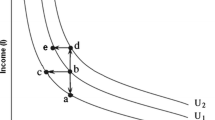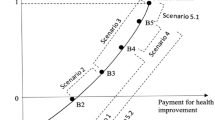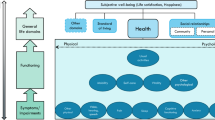Abstract
There is an extensive body of empirical research that focuses on the societal monetary value of a quality-adjusted life year (MVQALY). Many of these studies have found the estimates to be inversely associated with the size of the health gain, and thus not conforming to the linearity assumption imposed in the QALY model. In this study, we explore the extent to which the MVQALY varies when it is associated with different types and magnitudes of quality of life (QoL) improvements. To allow for a comprehensive assessment, we derive the MVQALY corresponding to the full spectrum of health gains defined by the EQ-5D-3L instrument. The analysis was based on a large and representative sample of the population in Spain. A discrete choice experiment and a time trade-off exercise were used to derive a value set for utilities, followed by a willingness to pay questionnaire. The data were jointly analysed using regression analyses and bootstrapping techniques. Our findings indicate that societal values for a QALY corresponding to different EQ-5D-3L health gains vary approximately between 10,000€ and 30,000€. MVQALY associated with larger improvements on QoL was found to be lower than that associated with moderate QoL gains. The potential sources of the observed non-constant MVQALY are discussed.
Similar content being viewed by others
References
Ryen, L., Svensson, M.: The willingness to pay for a quality adjusted life year: a review of the empirical literature. Health Econ. (2014). https://doi.org/10.1002/hec.3085
Nimdet, K., Chaiyakunapruk, N., Vichansavakul, K., Ngorsuraches, S.: A systematic review of studies eliciting willingness-to-pay per quality-adjusted life year: does it justify CE threshold? PLoS One 10, e0122760 (2015). https://doi.org/10.1371/journal.pone.0122760
Baker, R., Chilton, S., Donaldson, C., Jones-Lee, M., Lancsar, E., Mason, H., Metcalf, H., Pennington, M., Wildman, J.: Searchers vs surveyors in estimating the monetary value of a QALY: resolving a nasty dilemma for NICE. Health Econ. Policy Law 6, 435–447 (2011). https://doi.org/10.1017/S1744133111000181
Claxton, K., Martin, S., Soares, M., Rice, N., Spackman, E., Hinde, S., Devlin, N., Smith, P.C., Sculpher, M.: Methods for the estimation of the National Institute for Health and Care Excellence cost-effectiveness threshold. Health Technol. Assess. 19(1–503), 5–6 (2015). https://doi.org/10.3310/hta19140
Vallejo-Torres, L., García-Lorenzo, B., Castilla, I., Valcárcel-Nazco, C., García-Pérez, L., Linertová, R., Polentinos-Castro, E., Serrano-Aguilar, P.: On the estimation of the cost-effectiveness threshold: why, what, how? Value Heal. (2016). https://doi.org/10.1016/j.jval.2016.02.020
Vallejo-Torres, L., García-Lorenzo, B., Serrano-Aguilar, P.: Estimating a cost-effectiveness threshold for the Spanish NHS. Heal. Econ. (United Kingdom). (2018). https://doi.org/10.1002/hec.3633
Vallejo-Torres, L., García-Lorenzo, B., Castilla, I., Valcárcel-Nazco, C., García-Pérez, L., Linertová, R., Polentinos-Castro, E., Serrano-Aguilar, P.: On the estimation of the cost-effectiveness threshold: why, what, how? Value Heal. 19, 558–566 (2016). https://doi.org/10.1016/j.jval.2016.02.020
Abellán-Perpiñán, J.-M., Pinto-Prades, J.-L., Méndez-Martínez, I., Badía-Llach, X.: Towards a better QALY model. Health Econ. 15, 665–676 (2006). https://doi.org/10.1002/hec.1095
Robinson, A., Gyrd-Hansen, D., Bacon, P., Baker, R., Pennington, M., Donaldson, C.: Estimating a WTP-based value of a QALY: the “chained” approach. Soc. Sci. Med. 92, 92–104 (2013). https://doi.org/10.1016/j.socscimed.2013.05.013
Pinto-Prades, J.L., Loomes, G., Brey, R.: Trying to estimate a monetary value for the QALY. J. Health Econ. 28, 553–562 (2009). https://doi.org/10.1016/j.jhealeco.2009.02.003
Bobinac, A., van Exel, N.J.A., Rutten, F.F.H., Brouwer, W.B.F.: GET MORE, PAY MORE? An elaborate test of construct validity of willingness to pay per QALY estimates obtained through contingent valuation. J. Health Econ. 31, 158–168 (2012). https://doi.org/10.1016/j.jhealeco.2011.09.004
Gyrd-Hansen, D., Kjaer, T.: Disentangling WTP per QALY data: different analytical approaches, different answers. Health Econ. 21, 222–237 (2012). https://doi.org/10.1002/hec.1709
Haninger, K., Hammitt, J.K.: Diminishing willingness to pay per quality-adjusted life year: valuing acute foodborne illness. Risk Anal. 31, 1363–1380 (2011). https://doi.org/10.1111/j.1539-6924.2011.01617.x
Nord, E., Enge, A.U., Gundersen, V.: QALYs: is the value of treatment proportional to the size of the health gain? Health Econ. 19, 596–607 (2010). https://doi.org/10.1002/hec.1497
Nord, E.: Beyond QALYs: multi-criteria based estimation of maximum willingness to pay for health technologies. Eur. J. Heal. Econ. 19, 267–275 (2018). https://doi.org/10.1007/s10198-017-0882-x
Bansback, N., Brazier, J., Tsuchiya, A., Anis, A.: Using a discrete choice experiment to estimate health state utility values. J. Health Econ. 31, 306–318 (2012). https://doi.org/10.1016/j.jhealeco.2011.11.004
Bansback, N., Hole, A.R., Mulhern, B., Tsuchiya, A.: Testing a discrete choice experiment including duration to value health states for large descriptive systems: addressing design and sampling issues. Soc. Sci. Med. 114, 38–48 (2014). https://doi.org/10.1016/j.socscimed.2014.05.026
Ramos-Goñi, J.M., Pinto-Prades, J.L., Oppe, M., Cabasés, J.M., Serrano-Aguilar, P., Rivero-Arias, O.: Valuation and modeling of EQ-5D-5L health states using a hybrid approach. Med. Care 00, 1–8 (2014). https://doi.org/10.1097/MLR.0000000000000283
Ramos-Goñi, J.M., Craig, B.M., Oppe, M., Ramallo-Fariña, Y., Pinto-Prades, J.L., Luo, N., Rivero-Arias, O.: Handling data quality issues to estimate the Spanish EQ-5D-5L value set using a hybrid interval regression approach. Value Heal. (2017). https://doi.org/10.1016/j.jval.2017.10.023
Rivero-Arias, O., García-Lorenzo, B., Valcárcel-Nazco, C.: Comparing adolescents and adult preferences to EQ-5D-Y health states using profile case best-worst scaling. Pap. Present. 33rd EuroQol Plenary Meet, Berlin. 15–16 Sept. (2016)
Norman, R., Viney, R., Brazier, J., Burgess, L., Cronin, P., King, M., Ratcliffe, J., Street, D.: Valuing SF-6D health states using a discrete choice experiment. Med. Decis. Making 34, 773–786 (2013). https://doi.org/10.1177/0272989X13503499
Flynn, T.N., Louviere, J.J., Marley, A.A., Coast, J., Peters, T.J.: Rescaling quality of life values from discrete choice experiments for use as QALYs: a cautionary tale. Popul. Health Metr. 6, 6 (2008). https://doi.org/10.1186/1478-7954-6-6
Norman, R., Mulhern, B., Viney, R.: The impact of different DCE-based approaches when anchoring utility scores. Pharmacoeconomics. 34, 805–814 (2016). https://doi.org/10.1007/s40273-016-0399-7
Badia, X., Roset, M., Monserrat, S., Herdman, M.: The Spanish VAS tariff based on valuation of EQ-5D health states from the general population. In: EuroQol plenary meeting rotterdam, pp 93–114 (1997)
Instituto Nacional de Estadística (INE): Cifras de población. https://www.ine.es (2017). Accessed 26 Jan 2019
Donaldson, C., Baker, R., Mason, H., Pennington, M., Bell, S., Lancsar, E., Jones-Lee, M., Wildman, J., Robinson, A., Bacon, P., Olsen, J.A., Gyrd-Hansen, D., Bech, T.K.M., Nielsen, J.S., Persson, U., Bergman, A., Protière, C., Moatti, J.P., Luchini, S., Prades, J.L.P., Mataria, A., Khatiba, R.A.: European value of a quality adjusted life year. https://research.ncl.ac.uk/eurovaq/EuroVaQ_Final_Publishable_Report_and_Appendices.pdf (2010). Accessed 13 Apr 2018
Ministerio de Sanidad Consumo y Bienestar Social: Encuesta Nacional de Salud de España. https://www.mscbs.gob.es/estadEstudios/estadisticas/encuestaNacional/home.htm (2017). Accessed 12 Dec 2017
Gyrd-Hansen, D.: Willingness to pay for a QALY. Health Econ. 12, 1049–1060 (2003). https://doi.org/10.1002/hec.799
Hammitt, J.K., Haninger, K.: Willingness to pay for food safety: sensitivity to duration and severity of illness. Am. J. Agric. Econ. 89, 1170–1175 (2007). https://doi.org/10.1111/j.1467-8276.2007.01079.x
Hammit, J.K., Graham, J.D.: Willingness to pay for health protection: inadequate sensitivity to probability? J. Risk Uncertain. 8, 33–62 (1999)
Veisten, K., Hoen, H.F., Navrud, S., Strand, J.: Scope insensitivity in contingent valuation of complex environmental amenities. J. Environ. Manage 73, 317–331 (2004). https://doi.org/10.1016/j.jenvman.2004.07.008
Martín-Fernández, J., Polentinos-Castro, E., del Cura-González, M.I., Ariza-Cardiel, G., Abraira, V., Gil-LaCruz, A.I., García-Pérez, S.: Willingness to pay for a quality-adjusted life year: an evaluation of attitudes towards risk and preferences. BMC Health Serv. Res. 14, 287 (2014). https://doi.org/10.1186/1472-6963-14-287
Acknowledgements
We want to thank Juan Manuel Ramos Goñi and Marcel Minke for their support with the survey design and implementation. We are very grateful to Juan Oliva Moreno, Fernando I. Sánchez Martínez and Eva M. Rodríguez Míguez for their comments on previous versions of this paper. We also want to thank all the researchers, health professionals and health economists that reviewed our survey, as well as all the participants that completed our questionnaire.
Funding
This work was undertaken in the framework of activities run by the Network of Health Technology Assessment Agencies, funded by the Ministry of Health, Social Services and Equality in Spain.
Author information
Authors and Affiliations
Corresponding author
Ethics declarations
Conflict of interest
The authors declare that they have no conflict of interest.
Additional information
Publisher's Note
Springer Nature remains neutral with regard to jurisdictional claims in published maps and institutional affiliations.
Appendices
Appendix 1: Questionnaire (selected sections)
Section A: Respondents’ health status

Section B: Discrete choice experiment

Section C: Willingness to pay

Section D: Time trade-off

Appendix 2: Choice set

Rights and permissions
About this article
Cite this article
Vallejo-Torres, L., García-Lorenzo, B., Rivero-Arias, O. et al. The societal monetary value of a QALY associated with EQ-5D-3L health gains. Eur J Health Econ 21, 363–379 (2020). https://doi.org/10.1007/s10198-019-01140-4
Received:
Accepted:
Published:
Issue Date:
DOI: https://doi.org/10.1007/s10198-019-01140-4




